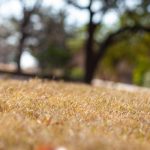Winter is often a time of reflection and rejuvenation. Our winter isn’t cold enough to ache our bones, but it is brisk enough to turn our thoughts to our landscape.
And there’s plenty to do — or in some cases not do — in the landscape, even in winter.
Lawns Water the lawn once a month at most if rain doesn’t materialize. Excess irrigation leads to fungal diseases like brown patch and take-all patch. Aerate and add a thin layer of compost in late winter or early spring. Aeration should be done with a core aerator, one that pulls plugs from the ground and the depth of compost should be between ¼ and ½ inch.
Perennials & Shrubs Not much to do with these until late winter. At that time, you have the option to prune perennials down to 3 inches above the ground or just leave the stems until new growth occurs and prune then. Pruning to 3 inches may be done every year, every two years or every five years. It is entirely up to you. Most perennials do best, however, with regular pruning to the ground.
Plant new perennials. The planting process is the same as trees: select a plant from our plant database, dig a wide hole, use the original soil plus a small amount of compost as backfill, water in everything well and cover with 2 inches of mulch.
Trees Winter time is the best time for pruning trees. No more than 20 percent of the canopy should ever be removed during a year. Topping — wanton indiscriminate pruning — is expressly forbidden. All branch removals must always occur at a branch junction or a bud. You can prune small trees yourself, but if you need to use the top rungs of the step ladder it’s time to call a certified arborist. Wound dressings are optional except in the case of oaks.Leaves are free fertilizer. Mow repeatedly while they are on the ground to speed up decomposition.
Other Maintenance Winter is always the best time to clean out the garage or storage building and your landscape equipment. Remove gasoline from all the power tools. Sharpen all blades and oil them down with mineral oil. Store any unused chemicals or fertilizer in clearly marked jars or tubs.




